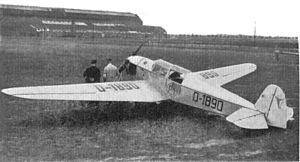BFW M.23
| M.23 | |
|---|---|
 | |
| Role | Two-seat sports aircraft |
National origin | Germany |
| Manufacturer | Bayerische Flugzeugwerke (BFW) |
| Designer | Willy Messerschmitt |
| First flight | early 1928 |
Number built | ≥ 100 |
Developed from | M.19 |
The BFW M.23, sometimes known as the Messerschmitt M 23, was a 1920s two-seat sporting aircraft designed by Willy Messerschmitt, and produced by Bayerische Flugzeugwerke (BFW). Examples won several prestigious races in 1929 and 1930.
Contents
1 Development
2 Operational history
3 Variants
4 Specifications (M.23b with Siemens Sh 14 engine))
5 See also
6 Notes
7 Bibliography
8 External links
Development
The BFW M.23,[1] (the M standing for its designer Willy Messerschmitt), was developed in response to a specification issued in 1929 by the German Aero Club for the Ostpreussenflug (East Prussian Circuit) competition. The result was an improved version of the M.19, with seating for two, and wings that could be folded for transport or storage.[1]
The M.23 was a small, conventional low-wing cantilever monoplane. It had a fixed undercarriage, the mainwheels mounted on a cranked axle, plus a tailskid. The fin and rudder assembly were broader and shorter than that of the M.19, though the shape varied with sub-type. A wide variety of engines were fitted, with power ranging from the 28 kW (38 hp) ABC Scorpion two-cylinder motor to the 112 kW (150 hp) of the seven-cylinder Siemens Sh 14a radial.[1]
The first of three production variants, the M.23a used low-powered engines and had a very angular vertical tail. The M.23b had curved upper fuselage decking and a more rounded tail and was produced with a large range of engines, both inline and radial. The length depended slightly on the engine fitted. The final version, the M.23c had an enclosed cockpit, the most powerful engines and was slightly larger (200 mm/8 in in span, around 500 mm/20 in in length) than the earlier variants. Its tail was again different, more rounded at the top and missing the elevator cutaway of the earlier models.[1]
At least one M.23b appeared on floats.[1]
Operational history
The M.23bs won both the 1929 Ostpreussenflug (Genet-powered) and the Circuit of Europe (Siemens Sh 13-powered) races. The M.23c was developed for, and won, the Circuit of Europe the following year with seven of them entered.

The winner of the 1930 Circuit of Europe, Fritz Morzik at Berlin Tempelhof, July 1930 with the M.23c
Production numbers are not certain, but 74 appear on the reconstructed German civil aircraft register;[2] 53 of these are M.23bs and 11 M.23cs. Many were bought by flying clubs for basic and acrobatic training. Other went to individual owners, with some familiar names amongst them like Ernst Udet (who made well publicised flights to Africa and to Greenland, the latter with Leni Riefenstahl as a passenger) and Rudolf Hess. In 1933, Erwin Aichele and his wife flew trouble-free for 13,000 km (8,000 mi) around the Mediterranean.[1]
The corresponding Romanian registers[3][4] show 26 more M.23bs, 14 of them locally built by ICAR (Intreprinderea de Constructii Aeronautice Romanesti, "Enterprise for Romanian Aeronautical Constructions") under licence from Messerschmitt. These were distinct from the Romanian modified version known as the ICAR Universal. The licensing deal was part of Messerschmitt's successful attempt to save a small core of staff from BFW when it went bankrupt in June 1931, a group that became Messerschmitt-Flugzeubau GmbH and survived until the reformation of BFW under the Nazis in 1933.[1]
Variants
- M.23
- initial open cockpit variant, powered by a 15 kW (20 hp) Daimler F7502 2-cyl horizontally-opposed engine.[5]
- M.23a
- either 28 kW (38 hp) ABC Scorpion or 34 kW (46 hp) Salmson 9ADb nine-cylinder radial.
- M.23b
- many engines fitted, including
- 70 kW (94 hp) inline upright ADC Cirrus III
- 85 kW (114 hp) inline ADC Cirrus Hermes
- 64 kW (86 hp) five-cylinder radial Armstrong Siddeley Genet
- 37 kW (50 hp) five-cylinder radial BMW X
- 62 kW (83 hp) radial Siemens Sh 13
- 86 kW (115 hp) seven-cylinder radial Siemens Sh 14
- 70 kW (94 hp) inline upright ADC Cirrus III
- M.23c
- Powered by several engine types, including
- 82 kW (110 hp) in-line inverted Argus As 8
- 112 kW (150 hp) radial Siemens Sh 14a.
- 82 kW (110 hp) in-line inverted Argus As 8
Specifications (M.23b with Siemens Sh 14 engine))

BFW M.23 3-view drawing from Aero Digest October 1929
Data from Smith 1971, p. 26
General characteristics
Crew: two
Length: 6.35 m (20 ft 10 in)
Wingspan: 11.80 m (38 ft 8½ in)
Height: 2.30 m (7 ft 6½ in)
Wing area: [6] 14.4 m2 (155 ft2)
Empty weight: 370 kg (816 lb)
Gross weight: 670 kg (1,477 lb)
Powerplant: 1 × 7-cylinder radial Siemens Sh 14, 86 kW (115 hp)
Performance
Maximum speed: 185 km/h (115 mph)
Range: 1,000 km (621 miles)
Armament
See also
Albatros L 100 and L.101- Arado L II
- Darmstadt D-18
- Junkers A 50
Klemm Kl 25E
Notes
^ abcdefg Smith 1971, pp. 23–6
^ http://www.goldenyears.ukf.net/reg_D-.htm
^ http://www.goldenyears.ukf.net/reg_CV-.htm
^ "Archived copy". Archived from the original on 2008-11-20. Retrieved 2009-01-10.CS1 maint: Archived copy as title (link).mw-parser-output cite.citation{font-style:inherit}.mw-parser-output .citation q{quotes:"""""""'""'"}.mw-parser-output .citation .cs1-lock-free a{background:url("//upload.wikimedia.org/wikipedia/commons/thumb/6/65/Lock-green.svg/9px-Lock-green.svg.png")no-repeat;background-position:right .1em center}.mw-parser-output .citation .cs1-lock-limited a,.mw-parser-output .citation .cs1-lock-registration a{background:url("//upload.wikimedia.org/wikipedia/commons/thumb/d/d6/Lock-gray-alt-2.svg/9px-Lock-gray-alt-2.svg.png")no-repeat;background-position:right .1em center}.mw-parser-output .citation .cs1-lock-subscription a{background:url("//upload.wikimedia.org/wikipedia/commons/thumb/a/aa/Lock-red-alt-2.svg/9px-Lock-red-alt-2.svg.png")no-repeat;background-position:right .1em center}.mw-parser-output .cs1-subscription,.mw-parser-output .cs1-registration{color:#555}.mw-parser-output .cs1-subscription span,.mw-parser-output .cs1-registration span{border-bottom:1px dotted;cursor:help}.mw-parser-output .cs1-ws-icon a{background:url("//upload.wikimedia.org/wikipedia/commons/thumb/4/4c/Wikisource-logo.svg/12px-Wikisource-logo.svg.png")no-repeat;background-position:right .1em center}.mw-parser-output code.cs1-code{color:inherit;background:inherit;border:inherit;padding:inherit}.mw-parser-output .cs1-hidden-error{display:none;font-size:100%}.mw-parser-output .cs1-visible-error{font-size:100%}.mw-parser-output .cs1-maint{display:none;color:#33aa33;margin-left:0.3em}.mw-parser-output .cs1-subscription,.mw-parser-output .cs1-registration,.mw-parser-output .cs1-format{font-size:95%}.mw-parser-output .cs1-kern-left,.mw-parser-output .cs1-kern-wl-left{padding-left:0.2em}.mw-parser-output .cs1-kern-right,.mw-parser-output .cs1-kern-wl-right{padding-right:0.2em}
^ Grey, C.G., ed. (1928). Jane's all the World's Aircraft 1928. London: Sampson Low, Marston & company, ltd. pp. 131c–132c.
^ http://www.eads.net/1024/en/eads/history/airhist/1920_1929/BFW_M_23.html BFW M 23
Bibliography
Smith, J Richard (1971). Messerschmitt an aircraft album. London: Ian Allan. ISBN 0-7110-0224-X.
External links
| Wikimedia Commons has media related to BFW M.23. |
- EADS: History of aviation > BFW M 23 (history, technical data and images)
The B.F.W. M.23. A German Light 'Plane with Many Variations, Flight, March 21, 1930